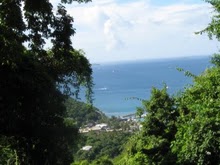It is getting more and more difficult to find birds these days other than the resident species. Last week the Robins were gathering in large numbers for their
migration
, the week before that it was the American Redstart and somewhere in that time frame the Cedar Waxwings all seemed to disappeared overnight. There are fewer
hawks
to be seen soaring in the sky and today I watched Sandhill Cranes dance on the currents of the wind as they head to their wintering grounds in huge numbers. Nothing is more fascinating and relaxing.
 |
Migrating Cranes riding the currents
|
 |
| Duck |
Yet I am sad, as I am every year at this time, but this year is both different and worse. I am actually bracing myself to say good bye to my avian friends, and trying to prepare myself for the fact that many species might actually not return in their same robust numbers next spring. Why am I concerned?
Many of the bird species migrating this fall will head towards the Gulf of Mexico, some to settle there for the winter and some to pass through it. Many depend on the numerous marshes along the shores of the Gulf for survival, or as a rest stop in order to build fat reserves before continuing their migration. If you wish to know more about the migration routes of birds just follow this link:
http://www.birdnature.com/flyways.html
 |
| Canada Geese |
The
Gulf oil spill, which I'm sure many of you have heard about, has already had a devastating effect on marine and avian life, and many naturalists and scientists are concerned with what continuing effects the contaminating spill will have on the environment, marine life and the hundreds of thousands of migratory birds this season and those beyond. The following link outlines scientists concerns:
http://www.theworld.org/2010/05/27/impact-of-gulf-oil-spill-on-migratory-birds/
 |
| Red-necked Grebe |
Although BP and the US government say that the Gulf Oil spill has been cleaned up and no longer poses a threat to either human or wildlife, I have heard that the ocean immediately surrounding the deep water horizon site and the area from there to the coast is devoid of life. I have also heard that there are no mosquitoes plaguing the human population living near the spill site and that local dogs do not have fleas due, as some speculate, to the evaporation of the dispersants used to break up the oil in the ocean. However, the truth about the damages done to the environment and the food chain in the Gulf of Mexico by BP's oil spill will likely not be realized for some time to come.
 |
| Golden Eye Duck |
|
|
|
|
|
|
 |
| Stooping Hawk |
The marshes along the Gulf coast, which are critical to migrating birds, have also been contaminated with oil. As has recently been revealed, the oil in the marshes has not been cleaned up, and is poisoning the food chain therein, beginning with crustaceans who have ingested the oil.
Shorebirds dependent on the shoreline to yield mollusks and crustaceans for their sustenance will be impacted directly, as there is still oil on the beaches when you dig down an inch or two. They will consume this oil along with their food, since they will be digging in the sand for it. Other species of birds, such as Ducks, Geese, Cormorant, Grebe, Herons and many more who feed on the same, as well as fish, crabs, frogs and aquatic plants will also be impacted directly. Raptors who depend on fish for survival, and even those who do not; those who feed on birds, insects and rodents, will be poisoned and/or their health will be compromised either directly or indirectly.
 |
| Swans |
Of the many news stories I have read and heard in relation to the BP disaster recently, not one details the continuation of clean up efforts since the well was capped. While it is reprehensible and irresponsible that the cleanup seems to have stopped, the question that remains is how many birds will survive migration this year? I for one sincerely hope that most do, but if there is no more clean up efforts this hope might be unrealistic. Scientists and volunteer bird watchers will be out in force this year along the Gulf coast to make head counts of the various bird species and to study how they are affected by the combined toxins of oil and dispersants now saturating the Gulf Coast region. I only wish they could use their findings to bring about an accountability to those responsible for the Gulf oil spill.
 |
| Migration route of Whooping Crane |
The following is a short list of birds which migrate to or through the Gulf of Mexico each year. Topping this list is the Whooping Crane who is still critically endangered.
- Osprey
- Red-necked Grebe
- Ruby-throated Humming bird
- Grey-cheeked thrush
- Swans
- Blue Heron
- Egret
- Mallard Ducks
- Golden Eye Ducks
- Turkey Vultures
- Swainson's Hawk
As promised this is just a short list of birds that will be affected. The following links will show you a more accurate picture of just how many birds could be affected and how.
http://www.newswise.com/articles/researchers-study-bird-migration-over-gulf-of-mexico?ret=/articles/list&category=latest&page=8334&search[status]=3&search[sort]=date+desc&search[has_multimedia]=
http://www.mpbn.net/Home/tabid/36/ctl/ViewItem/mid/3478/ItemId/12604/Default.aspx
Susan




















No comments:
Post a Comment